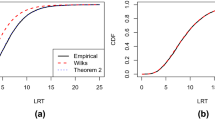Abstract
This is a short story about John C. Loehlin who is now at the University of Texas at Austin, dealing with his original simulation models and developments, which led to his current latent variable models. This talk was initially presented at a special meeting for John before the BGA in Rhode Island, and I was very pleased to contribute. It probably goes without saying, but John helped create this important society, has been a key contributor to this journal for several decades, and he deserves a lot for this leadership.
Similar content being viewed by others
References
Apter M (1971) The computer simulation of human behavior. Wiley, New York
Bower GH (1994) A turning point in mathematical learning theory. Psychol Rev 101(2):290–300
Cattell RB (1960) The multiple abstract variance analysis equations and solutions. Psychol Rev 67(6):353–372
DeFries JC, Vandenberg SG, McClearn GE (1976) Genetics of specific cognitive abilities. Annu Rev Genet 10(1):179–207
Hovland CI (1960) Computer simulation of thinking. Am Psychol 15:687–693
Jinks JL, Fulker DW (1970) Comparison of biometrical genetical, MAVA, and classical approaches to the analysis of human behavior. Psychol Bull 73(5):311
Lewis RA (1971) A streamlined version of the Aldous simulation of personality. Educ Psychol Measur 31:283–285
Loehin JC (1961) Word meanings and self descriptions. J Abnorm Soc Psychol 62(1):28–34
Loehlin JC (1962) The personality of ALDOUS. Discovery 23:23–26
Loehlin JC (1963) A computer program that simulates personality. In: Tompkins SS, Messick S (eds) Computer simulation of personality. Wiley, New York, pp 189–211
Loehlin JC (1965a) “Interpersonal” experiments with a computer model of personality. J Pers Soc Psychol 2(4):580–584
Loehlin JC (1965b) Some methodological problems in Cattell’s Multiple Abstract Variance Analysis. Psychol Rev 72:156–161
Loehlin JC (1968) Computer models of personality. Random House, New York
Loehlin JC (1979) Combining data from different groups in human behavior genetics. In: Royce JR, Mos LP (eds) Theoretical advances in behavior genetics. Sijthoff & Noordhoff, Germantown
Loehlin JC (1982) Are personality traits differentially heritable? Behav Genet 12(4):417–428
Loehlin JC (1985) Comments on path analysis talks. Biennial Meeting of the Society for Research in Child Development. Austin, TX
Loehlin JC (1987) Latent variables modeling: an introduction to factor, path, and structural analysis. Erlbaum: Hillsdale (5th edition, revised, 2007)
Loehlin JC (1993) Steven G. Vandenberg (1915–1992). Behav Genet 23(2):113–115
Loehlin JC (2002) The IQ paradox? Resolved: still an open question. Psychol Rev 109(4):756–758
Loehlin JC, Horn JM (2000) Stoomiller on restriction of range in adoption studies: a comment. Behavioral Genetics 30(3):245
Loehlin JC, Vandenberg SG (1966) Genetic and environmental components in the covariation of cognitive abilities: an additive model. University of Louisville, Louisville Twin Study
Loehlin JC, Vandenberg SG (1968) Genetic and environmental components in the covariation of cognitive abilities: an additive model. In: Vandenberg SG (ed) Progress in human behavior genetics. Johns Hopkins Press, Baltimore
Loehlin JC, Horn JM, Willerman J (1989) Modeling IQ change: evidence from the Texas Adoption Study. Child Dev 60:993–1004
Loehlin JC, Neiderhiser JM, Reiss D (2005) Genetic and environmental components of adolescent adjustment and parental behavior: a multivariate analysis. Child Dev 76(5):1104–1115
Martin NG, Eaves LJ (1977) The genetical analysis of covariance structure. Heredity 38(1):79–95
McArdle JJ (1973) STUD: the simulation of a college student. Unpublished Manuscript, Department of Psychology, Franklin & Marshall College
McArdle JJ (1986) Latent variable growth within behavior genetic models. Behav Genet 16(1):163–200
McArdle JJ, Goldsmith HH (1990) Alternative common factor models for multivariate biometric analyses. Behav Genet 20(5):569–608
McArdle JJ, Prescott CA (1996) Contemporary models for the biometric genetic analysis of intellectual abilities. In: Flanagan DP, Genshaft JL, Harrison PL (eds) Contemporary intellectual assessment: theories, tests and issues. Guilford Press, New York, pp 403–436
McArdle JJ, Prescott CA (2005) Mixed-effects variance components models for biometric family analyses. Behav Genet 35(5):631–652
Murray HA (1938) Explorations in personality. Oxford University Press, New York
Plomin R, DeFries JC, Loehlin JC (1977) Genotype–environment interaction and correlation in the analysis of human behavior. Psychol Bull 84(2):309
Sun R (2001) Cogniive science meets multi-agent systems. A prolegomenon. Philos Psychol 14(1):5–28
Tomkins SS, Messick S (1963) Computer simulation of personality, frontier of psychological theory. Wiley, Hoboken
Turing AM (1950) Computing machinery and intelligence. Mind 59(36):433–460
Acknowledgments
This research is funded by a NIH-MERIT Grant #AG07137-23 from the NIH-National Institute on Aging to the first author. Thanks also to Professor Eric Turkheimer, one of J. C. Loehlin’s many students, now teaching at the Department of Psychology, University of Virginia, for recognizing my interest in contributing as well as his useful editing to this well deserved festschrift.
Conflict of interest
John J. McArdle declare that he has no conflicts of interest.
Human and Animal Rights and Informed Consent
This article does not contain any studies with human or animal subjects performed by any of the authors.
Author information
Authors and Affiliations
Corresponding author
Rights and permissions
About this article
Cite this article
McArdle, J.J. Loehlin’s Original Models and Model Contributions. Behav Genet 44, 614–619 (2014). https://doi.org/10.1007/s10519-014-9688-0
Received:
Accepted:
Published:
Issue Date:
DOI: https://doi.org/10.1007/s10519-014-9688-0




